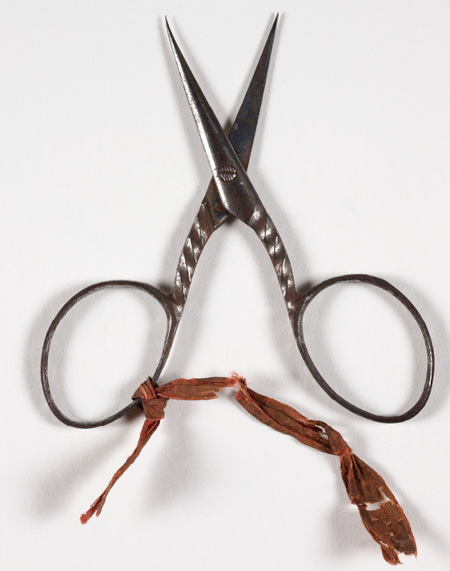This article is taken from PN Review 273, Volume 50 Number 1, September - October 2023.
Pictures from a Library
Pictures from the Rylands Library
The ‘Possessive Apostrophe’ in Elizabeth Gaskell’s Scissors

A pair of scissors, probably made of crucible steel in Sheffield, nineteenth century.
(© University of Manchester 2023)
A seemingly ‘beguilingly indigestible mix of dislocated personalia’ (Nicola J. Watson), including an ink stand, quill pens, paper knife, bodkins and sewing scissors (shown here) survive secreted amongst Elizabeth Gaskell’s papers in the Rylands. Evinced in the use of a possessive apostrophe, these scissors are tied by association to the span of Gaskell’s specific nineteenth-century life. Yet, as many have observed, objects have agency in their own right and in the language of obdurate materiality can be relied upon to speak for themselves.
Before crossing the Pennines to take up residence in Manchester’s Dover Street or Plymouth Grove, these scissors were most likely made in Sheffield which had, since the sixteenth century, been the centre of high-quality cutlery production. By the beginning of the nineteenth century the skilled artisans of some sixty companies were forging, grinding, riveting, filing, polishing and burnishing scissors, just like these, through a series of operations that required over 170 steps which were carried out by hand, ‘one pair at a time’ (Mary C. Beadry). Made up of an ecosystem of small workshops operating as household units, businesses and skills were passed down through families over generations (Beadry), with much of the heavy and dirty work of ‘finishing’ being carried out by women known as ‘buffer girls’ (Laura Bracey). As an unmechanised trade, at least until the end of the nineteenth century, these ...
The page you have requested is restricted to subscribers only. Please enter your username and password and click on 'Continue':
If you have forgotten your username and password, please enter the email address you used when you joined. Your login details will then be emailed to the address specified.
If you are not a subscriber and would like to enjoy the 292 issues containing over 11,700 poems, articles, reports, interviews and reviews,
why not subscribe to the website today?
